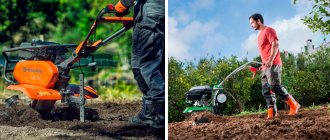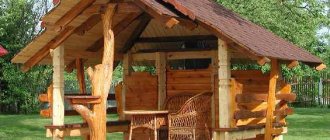Types of motor cultivators
All types of motor cultivators are divided into groups by weight:
- Ultralight (up to 15 kg).
- Light (up to 40 kg).
- Medium (45−60 kg).
- Heavy (over 60 kg).
Typically, motor cultivators from ultra-light to heavy are equipped with engines of increasing power from 1.5 to 10 hp. With. However, it also happens that the entire line, except for the heavy one, is equipped with an engine of one (2 hp) power. This is due to the fact that the motor cultivator needs weight for higher pressure on the soil. If the pressure is not enough, the cultivator often “bounces” in denser areas of the soil.
As part of the small-scale mechanization fleet, there is another device that is close to a motor cultivator in design and purpose. This is a walk-behind tractor. Although walk-behind tractors are sometimes classified as heavy motor-cultivators, they should be distinguished. The walk-behind tractor is not only heavier in weight and has a more powerful drive. The fundamental difference lies in the design.
The walk-behind tractor has a more powerful frame and a developed fastening system, various suspension devices, which can include a plow, a harrow and much more. A walk-behind tractor is essentially a mini-tractor without a driver's seat. It can even be used for transporting goods by mounting a small body or trolley on wheels to it. That is, if a motor-cultivator is structurally intended only for tillage, a walk-behind tractor is a universal draft device.
diesel engines are often installed , which operate more steadily than gasoline engines at low speeds.
Motor cultivators can be equipped with an electric drive. The advantage of an electric cultivator is the absence of exhaust, which makes it an indispensable assistant when working in closed greenhouses and winter gardens. When working in small local areas, as they are connected to the power outlet by a cable.
At the same time, you need to work with them carefully so as not to damage the electrical cable with the cutter.
Manufacturers of motor cultivators
By manufacturer, motor cultivators can be divided into four large groups
- European.
- Japanese.
- Belarusian, Russian and Ukrainian.
- Chinese.
Although most developed countries produce motor cultivators, among them the following manufacturers deserve special mention:
- Europe: France (Pubert, Cayman), Italy (BENASSI, Bertollini), Germany (MTD, Wolf Garten), and Denmark (Texas);
- USA - Craftsman, Partner, Parton, Champion (together with China);
- Japan - Honda;
- Korea (South) - Hyundai.
Particularly popular brands
Russia produces the following brands:
- mole, mole-2;
- favorite;
- leader;
- master;
- Neva.
A few words about the Chinese manufacturer
China is a country of small farms in which the motor cultivator has found the widest application. It is also the manufacturer of the cheapest motor cultivators in the world. However, mechanical engineering in China has a number of disadvantages.
First of all, China has recently started producing its own metal and its quality leaves much to be desired. Therefore, machines that have a large number of metal structures are inferior to European, American and Japanese products in terms of strength and durability of metal products, even if they are well-known brands and brands produced under the supervision of parent companies. The same applies to plastic products. Exceptions include assemblies made from parts manufactured in the West and Japan.
especially often fail , sometimes after one season of operation, such as:
- cylinder rings;
- plastic transmission gears;
- chains;
- wheel forks.
There are very frequent cases when the fasteners in the assembly were made in bad faith or they forgot to make the fastenings altogether.
However, there are a large number of motor cultivators produced by unknown small companies, which, as a rule, copy outdated models of well-known brands. The specificity of Chinese production is such that copyright and author's supervision are practically absent. Such motor cultivators are designed for the post-Soviet market of agricultural machinery consumers. Their cost is 2-3 times lower than their Western and Japanese counterparts. Chinese production is masked by proud names in Slavic and European languages, for example Bulat, Zubr, Vulcan, Aurora, Proton, Centaur, Zarya, Sadko, Zirka, etc.
Recent Entries
Chainsaw or electric saw - what to choose for the garden? 4 mistakes when growing tomatoes in pots that almost all housewives make Secrets of growing seedlings from the Japanese, who are very sensitive to the soil
All of the above does not mean that China does not produce quality products. In China, there are factories producing Chinese brands, the products of which have received European quality standards. Such factories include Chongqing Weima Agricultural Machinery Co Ltd. Weima brand products under the Scout brand are successfully exported to 50 countries. However, its price is higher than the price of nameless consumer goods.
Design of motor cultivators
The common components of most multicultivators are:
- frame;
- two- or four-stroke gasoline internal combustion engine;
- a tank for gasoline, or, as in the case of the Mole motor-cultivator, a gasoline-oil fuel mixture;
- U-shaped hand-held device with control handles mounted on it;
- rotor for mounting cutters for various purposes;
- bracket device for attaching the opener and additional attachments (hiller or trolley attachment);
- one, two or three wheels.
The most important component of a motor cultivator is the engine. The best engines for powering motor cultivators are Briggs & Stratton USA, Subaru and Honda Japan, Tecumsen Italy. These engines are used to power high-quality motor cultivators from other manufacturers.
Motor cultivator Neva
The small-sized motor cultivator Neva MK-100 and other models are produced by the well-known Russian manufacturer of small motorized agricultural machinery, JSC Red October - NEVA.
MK-100 (name according to GOST) is used for loosening, leveling the soil, weeding, and applying complex fertilizers. The use of an attachment greatly expands the technological capabilities of a motor cultivator. Products of the NEVA Mototechnics trademark are sold in 250 stores and serviced in 160 service centers in Russia and the CIS countries. Neva models are equipped with world-famous Briggs&Stratton and Honda engines.
Multicultivator operation
The main job of a motor cultivator is to loosen the soil using star cutters. Unlike a plow, a milling cutter does not turn over the soil layer, which prevents soil erosion and is a more progressive agrotechnical method of tillage. The motor cultivator is controlled by a person walking behind the device using a U-shaped curved structure with control handles.
The control handles are equipped with a clutch handle and a gear selector, including forward and reverse. The presence of a reverse gear is important in cases where the cutters “get stuck” in a heavy area of dense or rocky soil, in order to avoid breaking the cutter and transmission when moving the machine back. At the same time as loosening, the roots of weeds are crushed.
Disc cutters can also be installed on the rotor, which can dig a groove for planting potatoes and form a dump edge, which can then be covered with soil again by swapping the left and right disk cutters. With their help, beds can be easily cut.
The most important element of a motor cultivator is the coulter. This is a rectangular metal rod mounted on a frame behind the cutters. It performs braking functions that force the cutters to go deeper into the ground. By setting the length of the coulter, we get the opportunity to adjust the depth of cut with the cutter of the earthen layer. In addition, if two coulters are installed, they allow maneuvering by pressing on the right or left control handles.
Viking motor cultivator
This model is produced in Austria. A universal unit that performs digging, uprooting, loosening, and digging out root crops. The VIKING range is constantly updated with new developments. All modifications of this brand have a stable design, reliable parts and precisely selected tools. To protect against damage there is a hard case with a durable casing and double polymer linings. The gearbox housing is made of aluminum, the worm shaft is made of hardened steel, and the worm wheel is made of bronze alloy.
The handles are covered with non-slip rubber, which allows you to confidently operate the unit. The forward and reverse gear control levers are equipped with an automatic safety lock, which eliminates malfunction of the technical device. When you engage forward gear, reverse gear is blocked and vice versa. For convenient delivery to the work site, the Viking HB 585 motor-cultivator is equipped with two rear wheels. An air intake device with a snorkel supplies dust-free air for engine operation. A special three-level limiter ensures precise movement of the cultivator along the track.
Fuel consumption
The gas tank of a motor cultivator is usually designed for 2 hours of intensive continuous work. Let us give examples of average fuel (gasoline) consumption for the running engine power of various types of motor cultivators. The data is indicative and, depending on the specific engine model, load and operating mode, may differ in one direction or another:
| Engine power, l. With. | Gasoline consumption, kg/hour | |
| 4 stroke | 2 stroke | |
| 3,5 | 0,9 | 1,5 |
| 3,7−5,0 | 0,9−1,0 | – |
| 6,0−7,0 | 2,1 | – |
How does a mocultivator differ from other types of cultivators?
A cultivator is a universal, small-sized technical tool for mechanizing excavation work in dacha and rural areas. Tillage is carried out using a rotary device, which loosens the soil without turning the layer, crushes and embeds weeds, and evenly mixes complex fertilizers with the soil. The cultivator is used for continuous pre-sowing plowing of the soil, leveling the soil surface, and removing soil crust.
There are three types of cultivators: motor cultivators, electric cultivators and walk-behind tractors. They differ in design, size and functionality.
Electric cultivator - pros and cons
The electric cultivator is equipped with an electric motor. Electric cultivators are the lightest and most compact means of garden mechanization. They are connected to the electrical network and are designed for loosening the soil in a flower bed and in a greenhouse, but are not suitable for serious plowing of a large area of land. The advantage of an electric garden cultivator is that there is no need to refuel and it is easy to maintain. The disadvantages of electric cultivators are: low drive power, limited working radius by the length of the cord and the placement of the socket, small loosening depth, inconvenience of working with a hanging cable. The functionality of electric cultivators is limited due to the lack of additional attachments.

Motor cultivator
A cultivator equipped with a gasoline engine is called a motor cultivator. An electric cultivator can only be compared with an ultra-light class motor cultivator. Both types of cultivators are suitable for cultivated soil on a plot of 2 to 5 acres, caring for plantings and weeding. Thanks to attachments, motor cultivators are capable of performing various agricultural work.
Walk-behind tractor
A walk-behind tractor is a more powerful cultivator with attachments, also with a gasoline engine. It differs from a motor cultivator in its design features. In motor cultivators, cutters for loosening the soil are fixed to the working shaft. In walk-behind tractors, the engine is a separate module on wheels, on which one or another equipment is installed, depending on the type of work. The walk-behind tractor package includes a cutter, plow, hiller, snow blade and even a cart with a seat. Some manufacturers classify walk-behind tractors as motor-cultivators. The walk-behind tractor is a more multifunctional technique.

In addition to cultivation, it is used for plowing, hilling plants, and cutting beds. And attachments expand the list of agricultural work, including those unrelated to land cultivation. For example, cutting grass with a mower, transporting goods on a cart.
Compared to a walk-behind tractor, a walk-behind cultivator is lighter, more compact, and more maneuverable, which is especially convenient when caring for flower beds and cultivating rows between beds, shrubs and trees. Even a teenager can operate a small cultivator, which is problematic with a walk-behind tractor weighing 70 kg. The motor cultivator weighs from 10 to 55 kg, the power is 1.8 - 6.5 hp. With such an “assistant” you can plow 2 acres of dacha plot or 1 hectare of virgin land in an hour. Thanks to rotary cutters and special attachments, the motor cultivator performs a variety of agricultural and technical work.
The optimal choice of motor cultivator
The first question you need to answer yourself when purchasing a motor cultivator is how it is to be used.
For working on one, two or three flower beds, a manual cultivator is quite suitable - the lightest version of a motor cultivator. However, if the area of the cultivated area is significant, the choice of motor cultivator depends on the area, soil quality, and the variety of work that the buyer intends to perform.
| Land area | Motor cultivator category | Engine power |
| Up to 6 acres | easy | Up to 3 l. With. |
| Up to 30 acres | average | 3−4 l. With. |
| Up to 60 acres | heavy | 5−7 l. With. |
There is no need to overpay money and solve the problem of warehousing and storing a powerful motor cultivator if the plot of land is 3-4 acres of local area, where you can plant a small garden or flower bed. If there are small beds on the site, or care for isolated trees is required, even an average motor cultivator with a wide grip will be clumsy and will not be able to provide high-quality tillage.
When choosing a manufacturer, you need to proceed from financial capabilities. Leading manufacturing countries are more expensive, but the quality of materials and engineering design is the highest.
Russia produces good motor cultivators in a fairly wide range. They are not as reliably made and designed as Japanese or German ones, but they are well adapted to our working conditions and repair service.
The most important features to consider when choosing a specific brand:
- weight;
- engine power;
- engine design (2-stroke, 4-stroke);
- number of gears;
- presence of reverse gear;
- working width of the attachment;
- possibility of installing a maximum range of attachments;
- presence of wheels;
- fuel consumption;
- availability of service centers;
- guarantee period.
Motor cultivator TEXAS
The reliable and easy-to-use motor cultivator TEXAS (Denmark) is used for cultivating summer cottages and small fields. A huge range of additional attachments allows you to perform almost all types of cultivation work. The removable handle makes it easy to transport and store the tool. The placement of three cutters on each side significantly increases the quality of tillage.
A powerful engine, removable cutters made of durable steel, and the reliability of the main components allow you to effectively cope with the most complex tasks and ensure a long period of trouble-free service.
Reviews
The car is “crude”, there is no service, repairs are under warranty - they are dragging their feet. Before you buy, make sure that there is a normal service center nearby. Before you know it, it will come in handy. It's like a brand. Korea. And the impression is the worst. I just started it up for the first time, worked for an hour on the small ones, black smoke came out, like from a steam locomotive. During the exhaust shots, the blue plastic casing with the Hyundai inscription on it, which covers the pulleys, melted. Lost progress. The engine stalled and would not start... I called the service center, instead of consulting, the standard answer was - bring it to the office, although we have no documentation or specialists. Well, we'll try to figure it out, but not earlier than in a week. Replaced the spark plugs with BOSCH ones and started up. But it somehow doesn’t work smoothly... Maybe it will work out. Break-in and all that.
Evgeniy, Saratov
I don't regret the money spent. He can do everything, including in the garden near the trees and helping to cultivate the beds. I want to try a hiller and add wheels. I bought it, but haven't tried it yet. And the fact that they write that the development is “crude” means that a bad dancer always has a crooked floor. Regarding the service, I can’t say anything, but so far, pah, pah, I haven’t needed it, I don’t think I will need it. Especially about the engine - powerful, it pulls anywhere. First, I tried two cutters, and then all four, but I didn’t feel any difference. It works reliably. And with two, and with four. It takes dense clay soil easily, well, I tinkered a little and got used to it.
Alexey, Moscow
My Hyundai T700 has been working for over a month now. I recommend. Good buy. No particular shortcomings were noticed. It would be better, of course, with reverse gear, but it would be more expensive. I think the design is simpler - there are fewer breakdowns.
Mikhail, Ryazan










